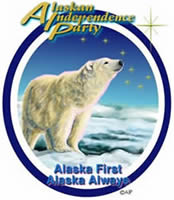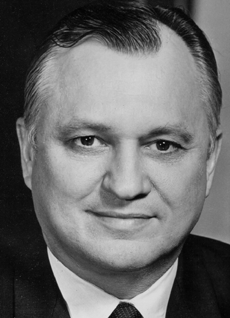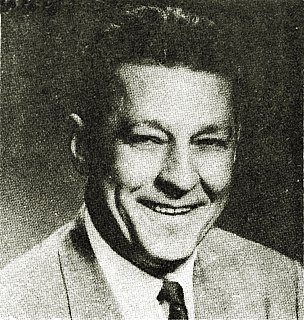
The Alaskan Independence Party (AKIP) is a political party and independence movement in the U.S. state of Alaska that advocates an in-state referendum which includes the option of Alaska becoming an independent country. The party also advocates positions similar to those of the Constitution Party, Republican Party and Libertarian Party, supporting gun rights, privatization, home schooling, and limited government.

Walter Joseph "Wally" Hickel was an American businessman, real estate developer, and politician. Starting out in Alaska during territorial days as a construction worker and subsequently a construction company owner/operator, he later became heavily involved with real estate development during Alaska's post-World War II boom period, building residential subdivisions at first, then branching out to building and operating shopping centers and hotels. Thrust into politics during the early 1950s by a power struggle within the territorial Republican Party and the battle to achieve statehood for Alaska, Hickel remained a formidable power in Alaskan politics for nearly a half century.

Keith Harvey Miller was an American Republican politician from Alaska. Miller was the second secretary of state of Alaska of Alaska under Walter Hickel. He became the third governor of Alaska after Hickel’s resignation. Under his tenure, Alaska came into sudden wealth after an oil lease sale on the North Slope created a revenue of $900 million.

The 2006 Alaska gubernatorial general election took place on November 7, 2006. The former mayor of Wasilla, Sarah Palin, was elected governor.

Joseph E. Vogler was the founder of the Alaskan Independence Party. He was also chair or gubernatorial nominee during most of the company's existence. He was also known, originally in his adopted hometown of Fairbanks, Alaska, and later statewide, as a frequent participant in governmental and political affairs and frequent litigant in court. Curiously enough, he was known to many non-political observers for his fashion sense, in particular his ubiquitous wearing of fedoras and bolo ties.

Leland Chancy Croft is a workers' compensation attorney and Democratic Party politician from the U.S. state of Alaska. Elected to the Alaska House of Representatives in 1968, he served a single term from 1969 to 1971. He was then elected to the Alaska Senate, serving in that body from 1971 to 1979, including serving as the president of the Senate from 1975 to 1977 during the 9th Alaska State Legislature.

The 1998 Alaska gubernatorial general election took place on November 3, 1998. The election resulted in a landslide for the Democratic incumbent, Tony Knowles, who had won the 1994 gubernatorial election by only 536 votes. Knowles was the first incumbent governor to attain re-election since 1978. As of 2019, this is the most recent election in which a Democrat was elected Governor of Alaska and the most recent election in which an Alaskan governor was re-elected.
Political party strength in Alaska has varied over the years. The communities of Juneau, Sitka, downtown and midtown Anchorage, the areas surrounding the College/University of Alaska Fairbanks campus and Ester and the "Alaska Bush" – rural, sparsely populated Alaska – stand out as Democratic strongholds, while the Kenai Peninsula, Matanuska-Susitna Valley, parts of Anchorage, and Fairbanks, Ketchikan, Wrangell, and Petersburg serve as the Republican Party electoral base. As of 2004, well over half of all registered voters have chosen "Non-Partisan" or "Undeclared" as their affiliation, despite recent attempts to close primaries.

The 1994 Alaska gubernatorial election took place on November 8, 1994, for the post of Governor of Alaska, United States. Democratic candidate Tony Knowles narrowly defeated Republican candidate Jim Campbell and Lieutenant Governor Jack Coghill of the Alaskan Independence Party. In the Republican Revolution year of the 1994 elections, Alaska's was the only governor's seat in the country to switch from Republican to Democratic.

The 2010 Alaska gubernatorial election took place on November 2, 2010. Former Governor Sarah Palin did not run, having resigned in July 2009. Incumbent Governor Sean Parnell, who as lieutenant governor succeeded Palin following her resignation, announced that he would seek a full term.

The 2010 Wisconsin gubernatorial election took place on November 2, 2010, to elect the Governor and Lieutenant Governor of Wisconsin. The 2010 Wisconsin partisan primary on September 14 determined which candidates advanced to the general election.

The 1990 Alaska gubernatorial election took place on November 6, 1990, for the open seat of Governor of Alaska. In 1989, incumbent Governor Steve Cowper, a Democrat, had announced that he would not seek re-election for a second term.

Louis Mead Treadwell II is an American businessman and politician who served as lieutenant governor of Alaska from 2010 to 2014. Treadwell is the former Chair of the U.S. Arctic Research Commission serving from 2006 to 2010. He is a member of the Republican Party and was a candidate for the 2014 U.S. Senate election in Alaska.

The 2014 United States Senate election in Alaska took place on November 4, 2014, to elect a member of the United States Senate to represent the State of Alaska, concurrently with the election of the governor of Alaska, as well as other elections to the United States Senate in other states and elections to the United States House of Representatives and various state and local elections.

The 1986 Alaska gubernatorial election took place on November 4, 1986, for the post of Governor of Alaska. Incumbent Governor Bill Sheffield, a Democrat who was seeking re-election, was defeated by Steve Cowper in the Democratic primary election on August 26, 1986.

The 1982 Alaska gubernatorial election took place on November 2, 1982, for the post of Governor of Alaska. To replace outgoing Republican governor Jay Hammond, Democratic nominee Bill Sheffield defeated three opponents: Republican nominee Tom Fink, Libertarian nominee Dick Randolph and Alaskan Independence Party nominee Joe Vogler. Hammond had endorsed his lieutenant governor, Terry Miller, who lost the Republican nomination to Fink in the primary election.
Jerry Ward is an American politician and businessman.

The 1970 Alaska gubernatorial election took place on November 3, 1970, for the post of Governor of Alaska. Former governor and Democratic candidate Bill Egan was able to defeat incumbent Republican governor Keith H. Miller after having lost his position in the previous election to Walter Hickel. Miller had been appointed to fill the rest of Hickel's term after Hickel was nominated to be the U.S. Secretary of the Interior under President Richard Nixon.

The 1966 Alaska gubernatorial election took place on November 8, 1966, for the post of Governor of Alaska. Republican challenger Walter Hickel narrowly defeated incumbent Democratic governor Bill Egan, falling just 3 votes short of an overall majority.

The 2018 Alaska gubernatorial election took place on November 6, 2018, to elect the governor and lieutenant governor of Alaska. In the primaries for recognized political parties, candidates for governor and lieutenant governor run separately. The winners of each respective primary for governor and lieutenant governor then become a joint ticket in the general election for their political party.




















